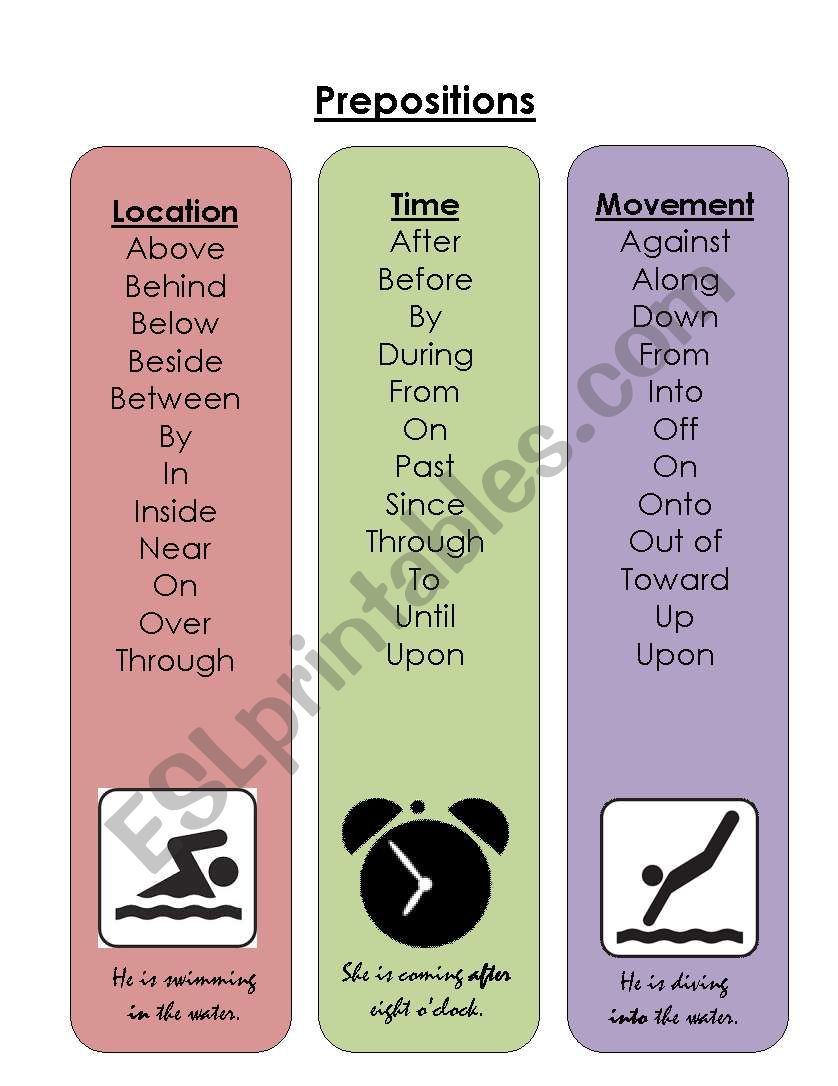
Mastering the Mnemonic Maze: The Indispensable Role of Prepositions Worksheets (of Place, Time, Movement)
In the vast and often perplexing landscape of English grammar, prepositions stand as deceptively small words wielding immense power. These tiny linguistic connectors – words like "in," "on," "at," "to," "from," "before," "after," "through," and "across" – are the unassuming architects of meaning, providing crucial context for how elements within a sentence relate to each other. They tell us where something is, when something happens, and how something moves. For language learners, both native and non-native speakers alike, mastering prepositions is not merely a matter of memorization but of deep conceptual understanding and extensive practical application. This is precisely where prepositions worksheets (of place, time, movement) emerge as an indispensable tool, offering structured, repetitive, and contextualized practice essential for true proficiency.
The challenge with prepositions lies in their often idiomatic nature and the subtle distinctions that can drastically alter a sentence’s meaning. While rules exist, they are frequently punctuated by exceptions, and the choice of preposition can depend heavily on the specific noun or verb it accompanies. Consider the subtle yet significant differences between "I am in the car," "I am on the bus," and "I am at the station." Each conveys a distinct spatial relationship. Similarly, "I will meet you at 7 PM," "I will meet you on Monday," and "I will meet you in December" illustrate the varying prepositions used for different units of time. For movement, "walk to the store," "jump into the pool," and "drive through the tunnel" showcase the precision prepositions lend to actions. Without a firm grasp of these nuances, communication becomes muddled, leading to misunderstandings and a lack of fluency.
Prepositions of Place: Pinpointing Locations

Prepositions of place answer the fundamental question: Where? They define the spatial relationship between two or more nouns. Common examples include "in" (enclosed space), "on" (surface), "at" (specific point/location), "under" (below), "above" (higher than, not touching), "next to" (adjacent), "between" (in the middle of two things), and "among" (in the middle of more than two things).

Prepositions worksheets (of place, time, movement) dedicated to place offer a variety of exercises designed to solidify this understanding. These might include:
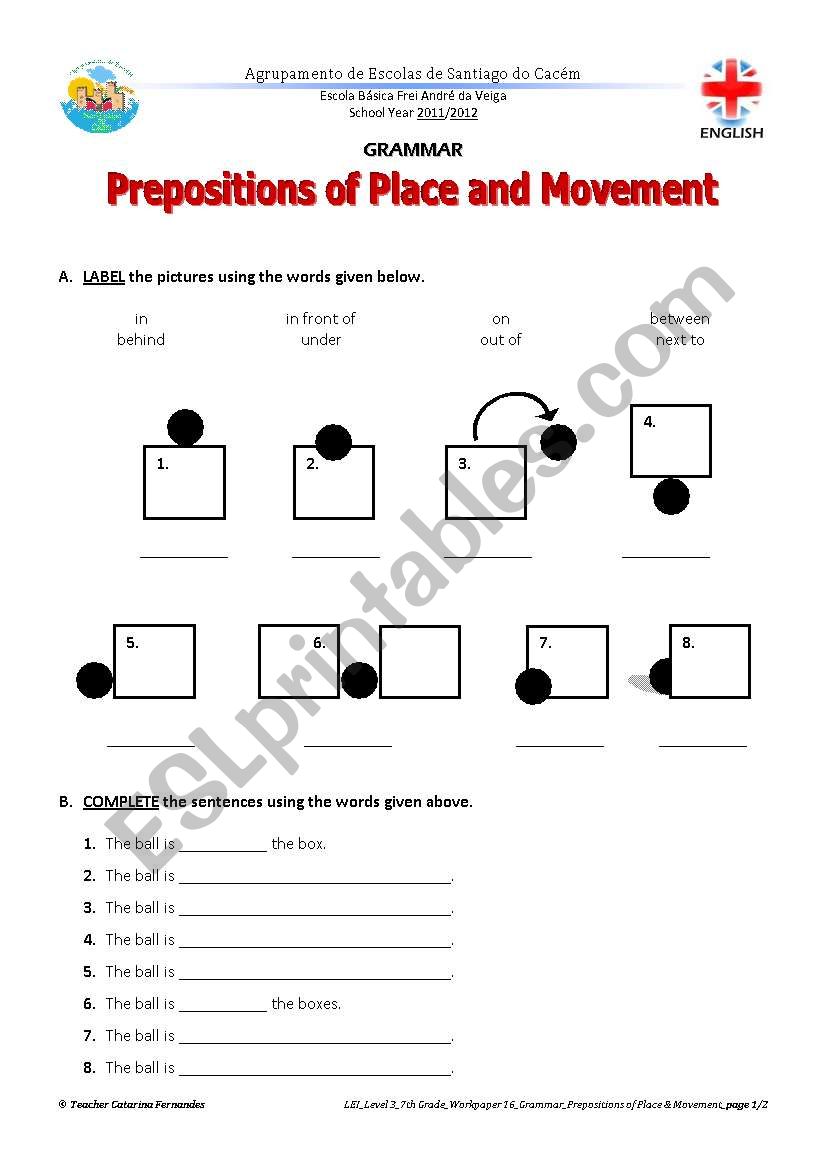
- Fill-in-the-blanks: Students complete sentences like "The book is the table" or "She lives London."
- Picture description: Worksheets often feature images of rooms, landscapes, or scenes, requiring students to describe the location of objects using appropriate prepositions (e.g., "The cat is sitting the armchair," "The lamp is the bed"). This visual context is incredibly helpful for learners.
- Multiple choice: Presenting sentences with several preposition options, forcing students to choose the most accurate one based on context.
- Sentence creation: Encouraging students to write their own sentences using given prepositions of place, reinforcing active recall and application.
- Error correction: Identifying and correcting incorrect preposition usage in provided sentences.
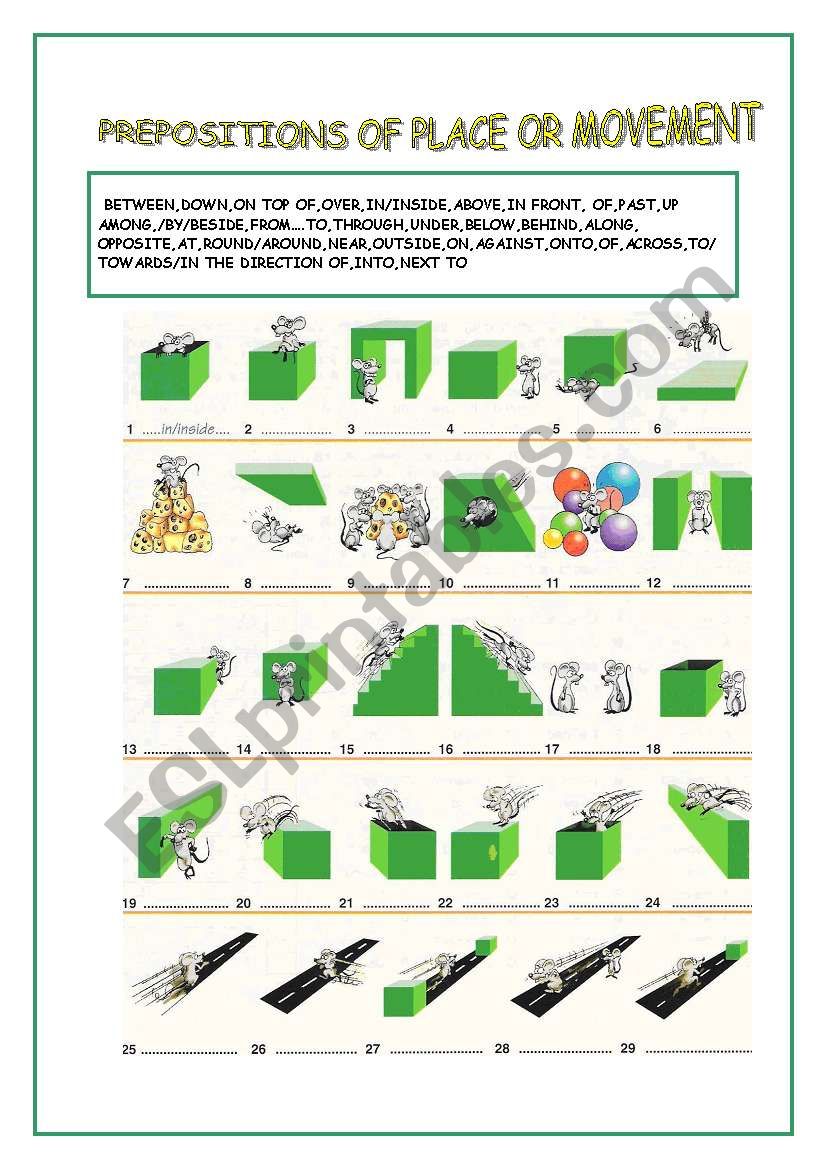

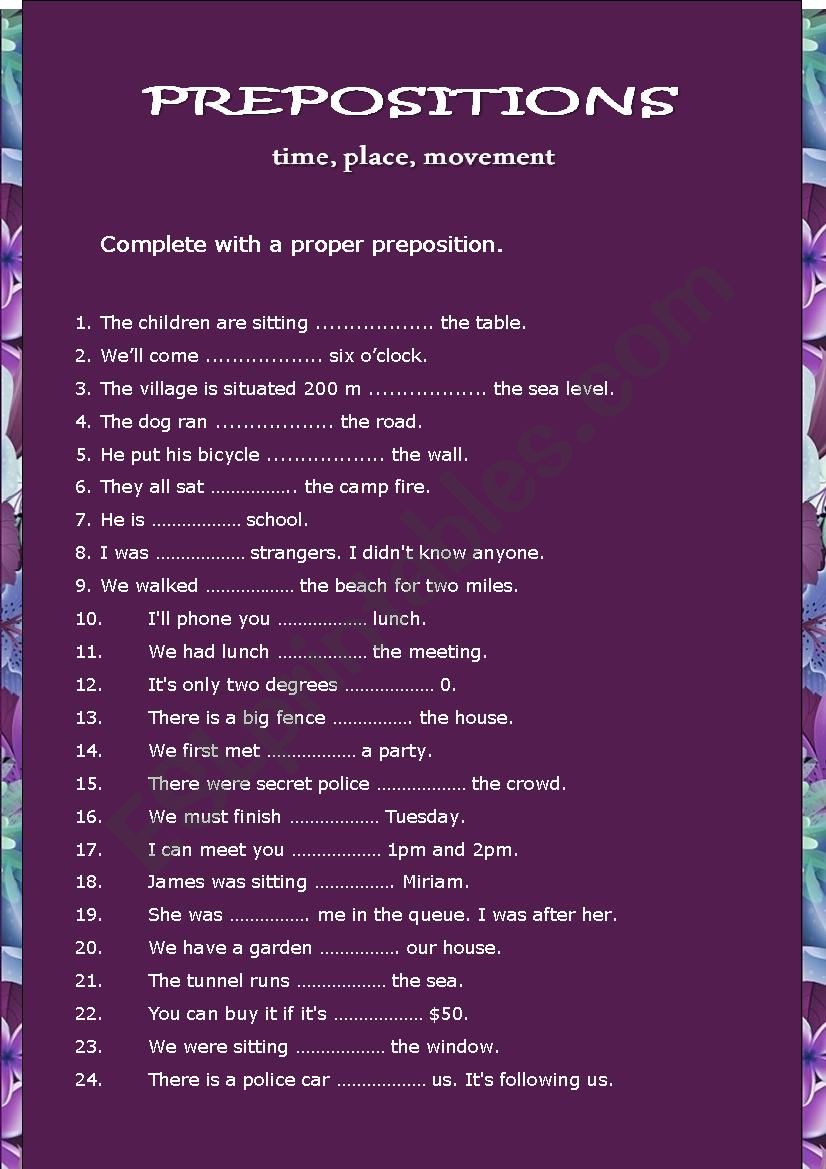
The beauty of these worksheets is their ability to isolate a specific concept for focused practice. By repeatedly engaging with "in," "on," and "at" in various place-related contexts, learners begin to internalize the subtle rules and common collocations, moving beyond rote memorization to intuitive usage.
Prepositions of Time: Navigating the Chronological Canvas
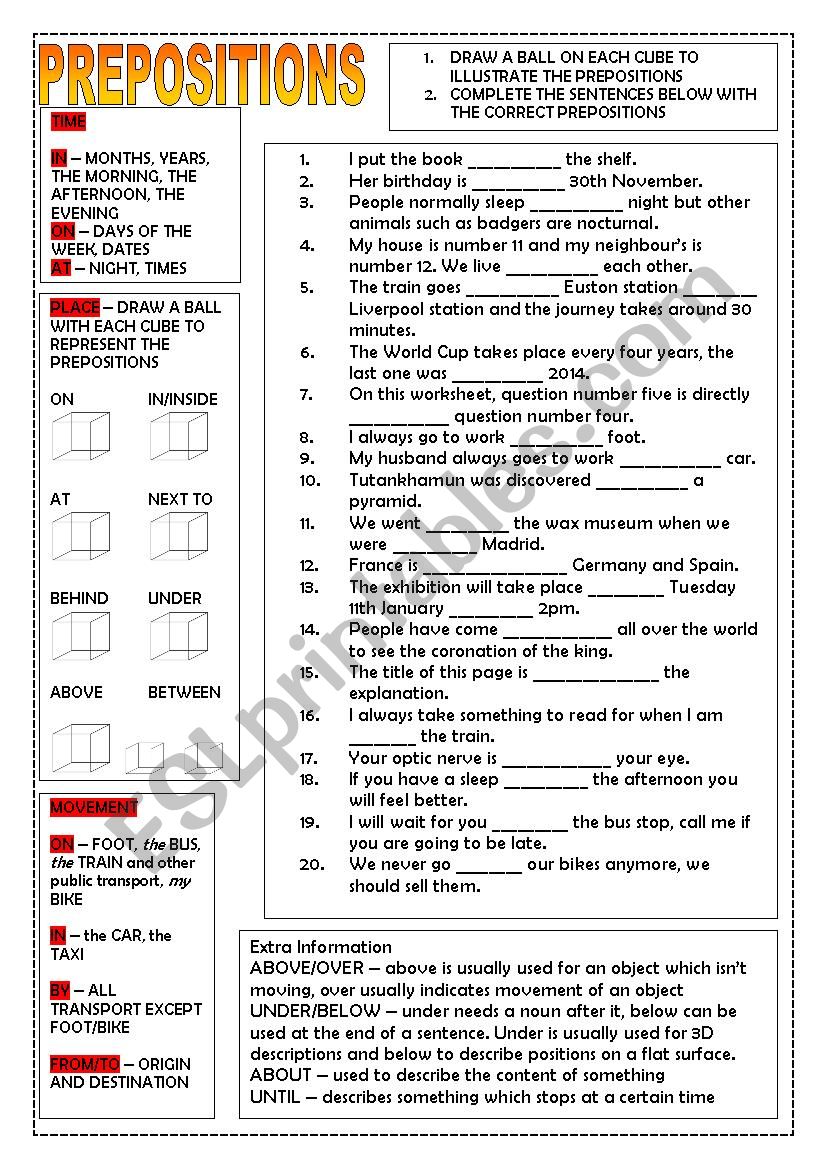
Prepositions of time answer the question: When? They indicate the temporal relationship of an event to a specific point or period. Key prepositions of time include "at" (specific time, holidays), "on" (days of the week, specific dates), "in" (months, seasons, years, parts of the day), "before" (earlier than), "after" (later than), "during" (throughout a period), "for" (duration), "since" (point in time from which something started), "by" (not later than), and "until" (up to a certain point).
The common confusion between "at," "on," and "in" for time is a prime example of where targeted practice is crucial. Students often struggle to differentiate between "at 8 o’clock," "on Tuesday," and "in July." Prepositions worksheets (of place, time, movement) specifically tailored for time prepositions address this directly through:

- Timetable exercises: Students complete schedules or diaries using correct prepositions of time.
- Event sequencing: Arranging events in chronological order and describing them using "before" and "after."
- Duration practice: Differentiating between "for" and "since" through contextualized sentences (e.g., "I have lived here five years" vs. "I have lived here 2018").
- Matching exercises: Pairing time expressions with their appropriate prepositions.
- Story completion: Providing narrative gaps where students must insert suitable prepositions of time to maintain chronological coherence.
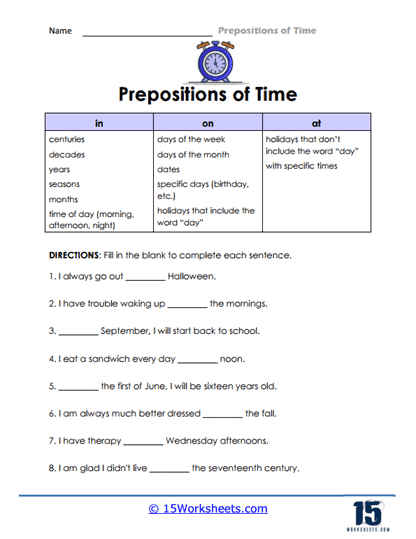
Through such structured repetition, learners develop a robust internal clock for English grammar, allowing them to precisely articulate when events occur, whether in daily conversations or complex narratives.
Prepositions of Movement/Direction: Charting the Course
Prepositions of movement or direction answer the question: How does something get from one place to another? They describe the path or trajectory of motion. Common examples include "to" (destination), "into" (entering an enclosed space), "onto" (moving onto a surface), "from" (origin), "out of" (exiting an enclosed space), "through" (moving within an enclosed space from one side to another), "across" (moving from one side to another of a flat surface), "along" (moving parallel to something), "up" (upwards), "down" (downwards), "past" (beyond), and "around" (in a circular motion).
Distinguishing between prepositions of place and movement can be tricky (e.g., "in" vs. "into," "on" vs. "onto"). Worksheets focused on movement are designed to highlight these distinctions:
- Map activities: Students follow directions on a map, filling in prepositions of movement as they describe the journey (e.g., "Go the bridge," "Turn right the corner").
- Action descriptions: Sentences describing physical actions require students to choose the correct preposition (e.g., "He jumped the swimming pool," "The bird flew the window").
- Video or GIF descriptions: Using short clips to prompt students to describe the movement observed, reinforcing real-world application.
- Story prompts: Providing beginnings of stories that require students to continue the narrative by describing character movement.
- Verb-preposition collocations: Focusing on common verbs of motion and the prepositions that typically accompany them (e.g., "run towards," "walk away from," "climb up").
These exercises transform abstract grammatical rules into dynamic, tangible actions, helping learners visualize and articulate movement with precision.
The Pedagogical Power of Prepositions Worksheets
Beyond simply providing practice, prepositions worksheets (of place, time, movement) offer several significant pedagogical advantages:
- Targeted Practice and Reinforcement: They allow learners to focus intensely on one grammatical concept at a time, reinforcing rules through repetition without the distraction of other complex grammatical structures. This focused approach is crucial for solidifying understanding.
- Active Learning: Worksheets require active engagement – thinking, choosing, writing – rather than passive reception. This active participation enhances retention and deeper processing of information.
- Identification of Learning Gaps: For educators, reviewing completed worksheets provides invaluable insight into common errors and areas where individual students or the class as a whole might be struggling. This diagnostic capability allows for tailored instruction and targeted remediation.
- Confidence Building: Successfully completing exercises builds confidence, encouraging learners to apply their knowledge in less structured environments like conversation and writing.
- Variety of Exercise Types: Good worksheets employ a diverse range of exercises (fill-in-the-blanks, matching, multiple choice, sentence construction, error correction, picture prompts) to cater to different learning styles and keep engagement high. This variety prevents monotony and reinforces the concept from multiple angles.
- Scaffolding Learning: Worksheets can be designed with increasing levels of difficulty, starting with simple identification and moving towards complex sentence construction or contextual application. This scaffolding ensures learners build a strong foundation before tackling more challenging aspects.
- Self-Assessment and Independent Learning: Many worksheets come with answer keys, enabling students to check their own work, learn from their mistakes, and take ownership of their learning process. They can be used effectively for homework, extra practice, or self-study.
Designing Effective Prepositions Worksheets
To maximize their impact, prepositions worksheets should be thoughtfully designed. Key considerations include:
- Clear Instructions: Ambiguous instructions can hinder learning.
- Contextualized Sentences: Isolated sentences are less effective than those that provide meaningful context, making the choice of preposition more intuitive and realistic.
- Relevance: Examples should be relatable to the learners’ experiences or interests.
- Visual Aids: Pictures, diagrams, and maps can significantly enhance understanding, especially for prepositions of place and movement.
- Gradual Difficulty: Start with simpler tasks and gradually introduce more complex scenarios or exceptions.
- Inclusion of Common Errors: Designing exercises that specifically target common errors can be highly effective.
- Answer Keys: Essential for self-correction and independent learning.
Integrating Worksheets into a Holistic Language Curriculum
While invaluable, prepositions worksheets should not exist in isolation. They are most effective when integrated into a broader language curriculum that also emphasizes speaking, listening, reading, and writing. After completing a worksheet on prepositions of time, for instance, a teacher might lead a discussion where students describe their daily routines, consciously using the prepositions they just practiced. Similarly, after a worksheet on prepositions of movement, students could role-play giving directions or describing a journey.
Interactive games, storytelling activities, and dictation exercises can further bridge the gap between worksheet practice and practical application. Technology, too, can play a role, with online quizzes and interactive exercises supplementing traditional printouts. The goal is to move from controlled practice to free and accurate production.
Conclusion
Prepositions, despite their modest size, are fundamental to achieving accuracy and fluency in English. They are the linguistic glue that binds sentences together, providing essential information about place, time, and movement. For learners navigating the complexities of these vital grammatical elements, prepositions worksheets (of place, time, movement) serve as an indispensable educational resource. They offer the structured, targeted, and repetitive practice necessary to demystify these often-tricky words, transforming potential pitfalls into stepping stones towards confident and precise communication. By understanding their pedagogical value and designing them effectively, educators can empower learners to master the mnemonic maze of prepositions, unlocking a deeper and more nuanced understanding of the English language.
